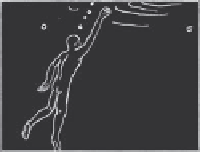Graphics Reference
In-Depth Information
But I was confused, confused by being moved by something I knew did not exist, and something
that was at once epic and mythical but also intensely intimate. This is Kong's real place in history.
Before Kong and O'Brien, animators such as Starewicj were making character-driven narratives,
and not just special ef ects. His
Reynard the Fox
contains some extraordinary character work, but
nothing before 1933 matched the moments where Kong tramples the line between special ef ect
and performance. The dei ning moment is the i ght between Kong and the T-rex. This was when
stop motion showed that it was not just a charming novelty, but a real art. This i ght, just minutes
long, is something that reminds me what this is all about. Both Cooper and O'Brien had studied
wrestlers in action, and thus Kong and the dinosaur do not just lay into each other, they weigh
each other up, reacting to each other. These puppets, especially Kong, appear to be thinking.
Sometimes they just pause, looking at each other, working out what to do next. I could see
a thought process, giving the illusion of being alive, and yet I knew it was not real. This captured
my imagination. The i ght is clumsy as they mistime jumps or grab the other awkwardly.
It's not slick and it is better for that. The violence is strong, but the telling moments of stillness
are still impressive. Young animators often dive into animating dinosaurs as all sound and fury,
not giving the action a chance to breathe, or to see the creatures reacting. This sequence is more
startling for the use of Max Steiner's music. Up until the i ght, the orchestra has been busy, but
suddenly, as the two creatures square up to each other, the orchestra stops, and the i ght carries
on in silence, save for the grunts, roars and Fay Wray. This makes the i ght brutal. At the end, Kong
famously l icks the dead T-rex's jaw back and forth, always getting a laugh. I initially thought this
an inappropriate moment of comedy. Today, though, I'm hoping the audience will laugh, and
they do. After the intense i ght, this is not just the director allowing the audience a bit of light
relief, but a moment to show Kong's complexity. He is not just a killing machine. It suggests that
his victory takes him a little by surprise. It gives him a l aw, and a depth that endears him to the
audience. Kong is not just a special ef ect, he is a complex character beautifully performed.
The other great moment is on top of the Empire State Building, when Kong is wounded by
the planes. The sequence is paced relentlessly, but amid the action there is a moment of
utter tenderness. With the end inevitable, Kong reaches out to Ann, stretching his i nger to
touch her, and then he falls. Absurdly, just writing this makes the tears well up. It is possibly
a ludicrous story, but told so well that this moment of connection is utterly credible and
heartbreaking. Even so, knowing that Fay Wray was reacting to nothing and that the mighty
ape was eighteen inches of fur and metal skeleton manipulated in another studio, and that an
animator managed to imbue an inanimate object with expressions that still work over seventy
years later is simply extraordinary and beautiful.
The i lm's background is just as extraordinary, with the right combination of oddball talents at
the right time. The i lm evolved out of recognition before reaching its i nal state. At one point a
komodo dragon was the central character, presumably before the beauty and the beast theme
was introduced. I love the folklore about Kong, especially about leaving a pair of pliers in view
on a miniature set. Rather than scrap the shot they were animated out as some sort of creature.
I like the story, as all stop motion animators have left something on the set at one
point and you face the same dilemma. In the
Pied Piper of Hamelin
there is a large
roll of Sellotape sitting in the background of a crowd scene. It would have been
noticeable had it just disappeared.
My favourite anecdote about Kong is that the release of Kong, with its impressive
sea serpent scene, is said to have coincided with, and possibly started, the i rst


Search WWH ::

Custom Search